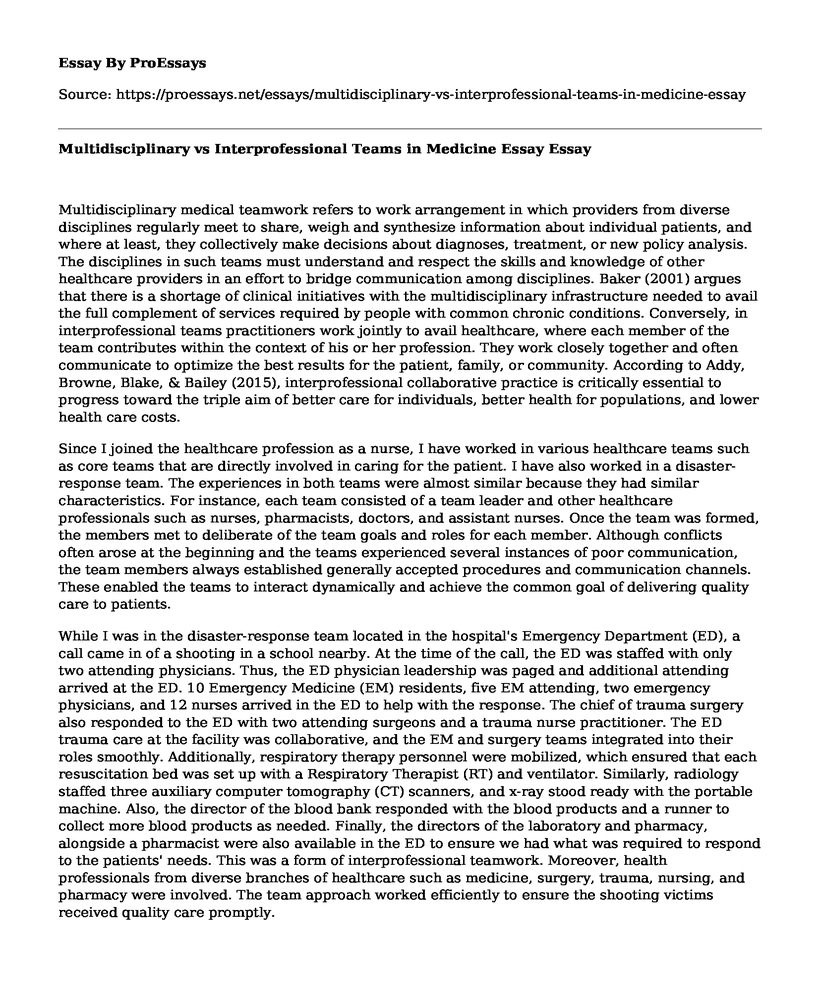Multidisciplinary medical teamwork refers to work arrangement in which providers from diverse disciplines regularly meet to share, weigh and synthesize information about individual patients, and where at least, they collectively make decisions about diagnoses, treatment, or new policy analysis. The disciplines in such teams must understand and respect the skills and knowledge of other healthcare providers in an effort to bridge communication among disciplines. Baker (2001) argues that there is a shortage of clinical initiatives with the multidisciplinary infrastructure needed to avail the full complement of services required by people with common chronic conditions. Conversely, in interprofessional teams practitioners work jointly to avail healthcare, where each member of the team contributes within the context of his or her profession. They work closely together and often communicate to optimize the best results for the patient, family, or community. According to Addy, Browne, Blake, & Bailey (2015), interprofessional collaborative practice is critically essential to progress toward the triple aim of better care for individuals, better health for populations, and lower health care costs.
Since I joined the healthcare profession as a nurse, I have worked in various healthcare teams such as core teams that are directly involved in caring for the patient. I have also worked in a disaster-response team. The experiences in both teams were almost similar because they had similar characteristics. For instance, each team consisted of a team leader and other healthcare professionals such as nurses, pharmacists, doctors, and assistant nurses. Once the team was formed, the members met to deliberate of the team goals and roles for each member. Although conflicts often arose at the beginning and the teams experienced several instances of poor communication, the team members always established generally accepted procedures and communication channels. These enabled the teams to interact dynamically and achieve the common goal of delivering quality care to patients.
While I was in the disaster-response team located in the hospital's Emergency Department (ED), a call came in of a shooting in a school nearby. At the time of the call, the ED was staffed with only two attending physicians. Thus, the ED physician leadership was paged and additional attending arrived at the ED. 10 Emergency Medicine (EM) residents, five EM attending, two emergency physicians, and 12 nurses arrived in the ED to help with the response. The chief of trauma surgery also responded to the ED with two attending surgeons and a trauma nurse practitioner. The ED trauma care at the facility was collaborative, and the EM and surgery teams integrated into their roles smoothly. Additionally, respiratory therapy personnel were mobilized, which ensured that each resuscitation bed was set up with a Respiratory Therapist (RT) and ventilator. Similarly, radiology staffed three auxiliary computer tomography (CT) scanners, and x-ray stood ready with the portable machine. Also, the director of the blood bank responded with the blood products and a runner to collect more blood products as needed. Finally, the directors of the laboratory and pharmacy, alongside a pharmacist were also available in the ED to ensure we had what was required to respond to the patients' needs. This was a form of interprofessional teamwork. Moreover, health professionals from diverse branches of healthcare such as medicine, surgery, trauma, nursing, and pharmacy were involved. The team approach worked efficiently to ensure the shooting victims received quality care promptly.
References
Addy, C. L., Browne, T., Blake, E. W., & Bailey, J. (2015). Enhancing interprofessional education: Integrating public health and social work perspectives. American Journal of Public Health, 105(S1), S106-S108.
Baker, A. (2001). Crossing the quality chasm: a new health system for the 21st century. BMJ: British Medical Journal, 323(7322), 1192.
Cite this page
Multidisciplinary vs Interprofessional Teams in Medicine Essay. (2022, Feb 16). Retrieved from https://proessays.net/essays/multidisciplinary-vs-interprofessional-teams-in-medicine-essay
If you are the original author of this essay and no longer wish to have it published on the ProEssays website, please click below to request its removal:
- Introduction to Ethics in Decision Making
- Paper Example on Merck Company and River Blindness
- Should Smoking in the Public Be Allowed? - Essay Sample
- Essay Example on Leadership: The Big Five Traits That Matter
- Research Paper on Height & Age: Survey Shows Relationship Between Two Variables
- Essay Example on Data Visualization: A Tool to Solve Real-World Problems
- Essay Sample on Healthcare System







